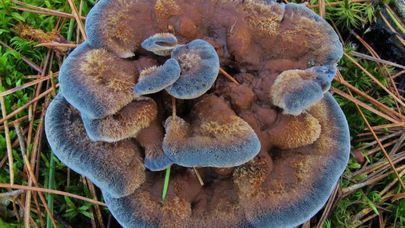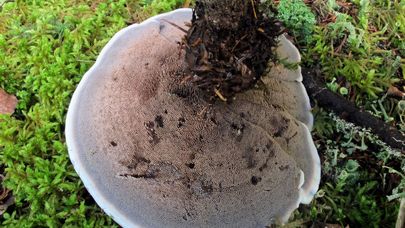Hydnellum caeruleum
Description
Hydnellum caeruleum differs from Hydnellum aurantiacum in its coloration but otherwise is very similar. When young, the cap includes shades of blue, blue-gray, and brown, with the paler blue tones occurring near the edge. The spines are brownish, with blue overtones prominent when young, and the stipe is orange-brown to brown. The flesh of the cap is bluish to grayish to nearly black, and that of the stipe is red- to orange-brown. Most of the blue colors disappear in age, and older fruitbodies look much the same as those of H. aurantiacum.
It is a widespread mushroom, occurring throughout much of North America, Europe, and temperate Asia.
Hydnellum alachuanum and Hydnellum cyaneotinctum are synonyms.
Common names: Blue-Gray Hydnellum, Bluish Hydnellum, Blue Spine, Blue Tooth, Bluish Tooth.
Mushroom Identification
Ecology
Mycorrhizal with conifers in most areas but also with live oaks and other hardwoods in coastal California and on the Gulf Coast; growing alone or gregariously; summer and fall (or overwinter in warm climates); widely distributed in North America.
Cap
Usually single but occasionally fused with other caps; 3-15 cm wide; top-shaped to convex, becoming flat or shallowly depressed; somewhat velvety; sometimes ridged or pitted; when fresh and young white to whitish or very pale yellowish, but usually with a bluish cast, becoming dingy tan to brownish over the center or overall; the pale margin often bruising blue.
Undersurface
Running down the stem; covered with crowded spines that are 3-6 mm long; whitish to pale grayish at first, becoming brownish to brown.
Stem
2-5 cm long; 1-3 cm thick at apex; more or less cylindric, or with a slightly swollen base; orange to orangish.
Flesh
Whitish to orangish or brownish, with zones of blue or brown; tough but pliant.
Odor and Taste
Mealy.
Chemical Reactions
KOH on flesh olive green to blackish or purplish black.
Spore Print
Brown.
Microscopic Features
Spores 5-6.5 x 4.5-5.5 µ; subglobose to irregular; with low warts. Clamp connections absent.
Medicinal Properties
Antitumor effects. Polysaccharides extracted from the mycelial culture of H. caeruleum and administered intraperitoneally into white mice at a dosage of 300 mg/kg inhibited the growth of both Sarcoma 180 and Ehrlich solid cancers by 60% (Ohtsuka et al., 1973).
Look-Alikes
-
Its cap usually is yellowish-brown with a whitish or very pale blue edge, the flesh is entirely blue, and the mushroom has a strong sweet anise odor.
Hydnellum ferrugipes
Distinct species that does not bruise blue. and which has blue zones in the flesh only after it has been dried for the herbarium.
Photo sources:
Photo 1 - Author: Steve Nelsen (sfnelsen) (CC BY-SA 3.0)
Photo 2 - Author: Erlon Bailey (CC BY-SA 4.0)
Photo 3 - Author: mycowalt (CC BY-SA 4.0)
Photo 4 - Author: mycowalt (CC BY-SA 4.0)
Photo 5 - Author: mycowalt (CC BY-SA 4.0)





